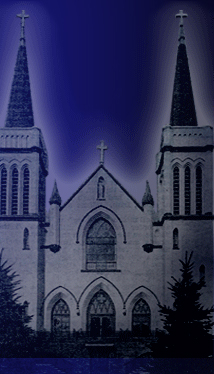History
| History: 1895 - 1919 1919-1945 1945-1968 1968-1995 1995-Present "Memories of Wilkes-Barre" by Father J.J. Curran First Pastor of Holy Saviour Church |
1895 - 1919
A century ago on November 5, 1895, the section of Wilkes-Barre known as Five Points was separated from the parish of Saint Mary of the Immaculate Conception on South Washington Street and was established as Holy Saviour - the second territorial parish in the city.
Holy Saviour was founded during the episcopacy of the Most Reverend William O'Hara, the first bishop of the Diocese of Scranton, and began to function under the able guidance and leadership of Rev. John J. Curran who was appointed as the first pastor.
The majority of the people living in the area were immigrants, or children of immigrants, from Ireland. Since Wilkes-Barre was situated favorably in the rich anthracite deposit which extended from below Nanticoke north for about sixty miles, most men found their employment in the large force of miners and laborers necessary to meet the constant and growing demand of the expanding coal industry. They were hard-working and faced many risks and dangers, including even death, in their daily toil.
A people of deep and abiding faith, the parishioners enthusiastically greeted the first pastor, Father Curran, who himself as a boy had worked in the mines in various capacities for eight years. One of the first things Father set out to do was to select a more suitable name for the area. He offered a prize of twenty dollars in gold to the person who would submit the most appropriate name, and from the thousands of ideas submitted, "East End" was selected and is still in use today.
Soon the erection of a temporary place of worship was begun. After each day's work in the mines, many men volunteered their services in erecting the edifice. They would gather at the corner of Hillard and Penn Streets with picks, shovels, and wheelbarrows to help with the construction. In a short time the foundation was laid and the building, a long, narrow wooden structure of plain design was completed the services held there.
Later, to make way for the ground-breaking of the present church, the temporary structure was moved to Worrall Street and subsequently used as a meeting hall for various societies.
Holy Saviour had, in its first pastor, a true shepherd and a man of great spiritual leadership. He was also a champion of labor, a staunch advocate of total abstinence, an ardent lover of music, and a talented organizer.
On May 12, 1902, the United Mine Workers of America, determined to win a living wage and better working conditions for the workers, closed down every anthracite operation in the state of Pennsylvania. A stalemate was created when the mine workers were unwilling to negotiate a Settlement. There was no substitute that could be used as fuel and basic industries were in danger of collapse.
Father Curran, who had become a friend of John Mitchell, the found of the United Mine Workers of America, not only defended the cause of the miners from the pulpit, but also furthered their interests by writing letters to the leaders of government and industry and by granting the press interviews and defending their rights to safer working conditions and a just wage.
President Theodore Roosevelt, impressed by Father Curran's intervention, summoned the mine owners to the White House and when they again refused to consider the demand of their employees, the President turned to Father Curran. A presidential commission was named which proposed binding arbitration. The mine owners surrendered and the miners won their first major victory.
The friendship which sprung up at this time between Father Curran and Theodore Roosevelt was a lasting one, and Roosevelt was a frequent visitor at the parochial residence on Worrall Street. A few years after the strike, when the annual Father Matthew Day Parade was held on October 10, 1912, over a half-million people turned out to greet its honored guests which included President of the United States, Theodore Roosevelt, His Eminence, James Cardinal Gibbons, and John Mitchell, and to hear them speak from a platform erected on the river common.
On October 24, 1909, fourteen years after the founding of the parish, the church - a red brick structure situated on an imposing site visible from many parts of Wyoming Valley - was formally dedicated.
It was a festive day in East End, beginning with the welcome extended at the Lehigh Valley Station to the Apostolic Delegate to this country from His Holiness, Pope Pius X, Archbishop Diomedi Falconio. The Archbishop was greeted by the visited bishops and priests from this city and different parts of the state who had been invited by Father Curran to assist in the Church's dedication. The entourage was escorted over the streets of the city by the Catholic Total Abstinence Union Regiment, headed by St. Anne's Band of Freeland. In East End the homes were decorated with the purple and white papal colors and the streets were brightened by flares set off by the happy members of the congregation.
On the day of the dedication the ceremonies included a Solemn High Pontifical Mass offered by Rt. Rev. Eugene Garvey, Bishop of Altoona. Among the clergy who assisted at the Mass were two native sons, Rev. John J. O'Donnell, at that time the pastor at Stowel, and Rev. Thomas F. Dougherty, pastor at Sunbury. The sermon was preached by Rev. William O'Donnell of Providence.
In the afternoon the sacrament of Confirmation was administered to a class of more than three hundred fifty children and adults by Bishop Hoban. At the evening services, which consisted of solemn vespers and benediction, Doctor Malone of Scranton and Archbishop Falconio addressed the congregation.
A gifted organizer, Father Curran established the Cadet Society for the youth of the parish, the St. Aloysius Society for the young men, and for the older men, the St. Matthew Society. From the social events which he encouraged among these societies, an abundance of latent talent was discovered and developed. Among some of the original presentations to which Father Curran devoted much of his time were: "The Irish Fair," "Kate Kearney's Cottage," "A Night in Ireland," and "Payday at the Bridge." One of the leading characters in every performance was Con McCole, later a mayor of the City of Wilkes-Barre, and an entertainer of national renown.
Father Curran remained as pastor at Holy Saviour Parish for twenty-three years, until January 12, 1919, when he was transferred to Saint Mary of the Immaculate Conception Church. On January 23, 1930, he was named Very Reverend Monsignor. He served as pastor of St. Mary's until his death in November 1936.











